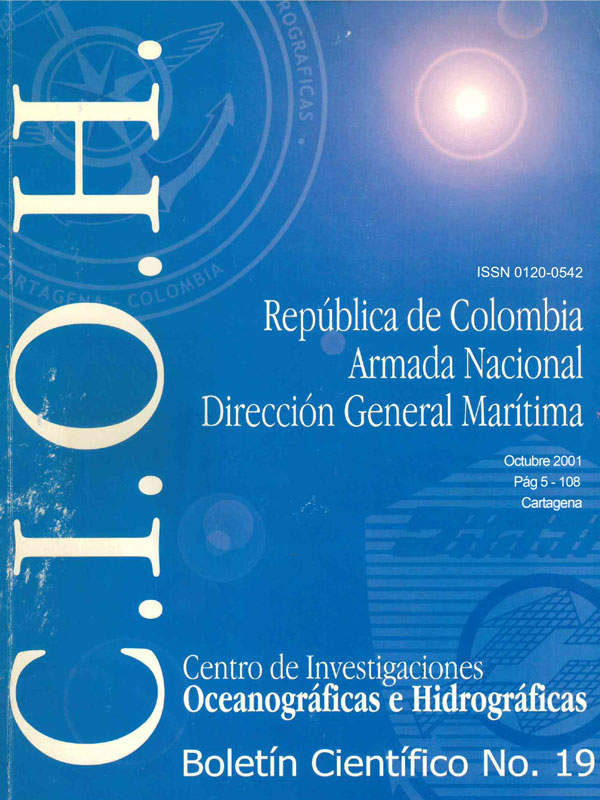Simulación numérica de un tsunami de origen lejano en su aproximación a la costa Pacífica colombiana
DOI:
https://doi.org/10.26640/22159045.100Keywords:
Colombia, Pacífico, Tsunami, height of the waveAbstract
Tsunami, originally from the Japanesse word tsu harbor and nami wave, are great energy sea waves able to destroy complete towns over the coast, (i.e. San Juan de la Costa, Colombia in 1979). It has been proved that tsunami can cause clamase over thousands of kilometers from its source (Chile 1960). The scientific comunity in Colombia, wonders if the Colombian Pacific Coast, severely stroke by near field tsunami in two opportunities, is also exposed to far field tsunami threat. Ibis work, calculated by means of a numerical solution, the initial believable and specific perturbations, generated at the sea surface as the result of an earthquake ocurred at the bottom of the sea, so as the height of the wave that results from the same phenomenon, close to the Colombian Pacific Coast. In this manner, it is given a tool to answer a fundamental question of natural threat, giving practical information, necessary for the management of the far field tsunami risk, in the Colombian Pacific Coast.
Downloads
References
• Goto, C. e Y. Ogawa, Numerical method of tsunami simulation with the leap-frog scheme. Japan. Reporte Técnico, 1982, 19p.
• Guibourg, S., P Heinrich, y R. Roger, Numerical modeling of the 1995 Chilean tsunami. Impact on French Polynesia, Geo. Res. Lett., France, Vol. 24, No 7, April 1, 1997, p. 775-778.
• lmamura, F y N. Shuto, Numerical simulation of propagation of far field tsunamis, Reporte Técnico, septiembre 1992, 29 p.
• Kanamori, H, Rupture Process of subduction zone earthquakes, Ann. Rey. Earth Planet Sci. Vol. 14, 1986, p. 239-322.
• Kuroiwa, J, Tsunamis, population evacuation and land use planning for disaster mitigation, localities studied in Peru, (1981-1984), Lima y Geneva, 1995,28 p.
• Mena, R, Una falsa alarma. Revista semestral de la red de estudios sociales en prevención de desastres en América Latina, especial predicciones, pronósticos, alerta y respuestas sociales. Enero - junio de 1996, No. 6, año 4, Lima, 1996, 28 p.
• Mader, C. L., Numerical modeling of water waves, Los Alamos Series in Basic and Applied Sciences. David, H. and L. M., Simmons, Jr, (ed), Vol 8. California, U.S.A. 1988.
• Meyer, Hj. y A. Velásquez, Conferencia Interamericana sobre reducción de los desastres naturales, desarrollada en Cartagena de Indias: 'Prevención de tsunami en Colombia'. Observatorio Sismológico, Universidad del Valle - Colombia. 1994.
• Meyer, Hj. y A. Velásquez, Aproximación al riesgo por tsunami, Reporte Técnico, Observatorio Sismológico de Sur Occidente, Universidad del Valle - Colombia, 1972.
• Okal, E. A., Seismic parameters controlling far-field tsunami amplitudes: A review. Natural Hazards 1, Klewer Academie Publishers, 1988, 69p.
• Okal, EA., Efects of variable bathymetry on the amplitud of telesismic tsunami: a ray tracing experiment, 1987, 35p.
• Robert, J. A. y Chen-Wu, Chien, The tsunami of march 28, 1964, as recorded at tide stations. ESSA Reporte Técnico, 1967, 16p.
• Soloviev, S. L. y CH. N. Go., Catalogue of tsunamis on the western shore of the Pacific Ocean. Translated from Russian by Slavonic Lenguages Section of Canada. USSR, 1984, 640 p.
Downloads
Published
Issue
Section
License
Attribution — You must give appropriate credit, provide a link to the license, and indicate if changes were made. You may do so in any reasonable manner, but not in any way that suggests the licensor endorses you or your use.
NonCommercial — You may not use the material for commercial purposes.
NoDerivatives — If you remix, transform, or build upon the material, you may not distribute the modified material.
No additional restrictions — You may not apply legal terms or technological measures that legally restrict others from doing anything the license permits.



